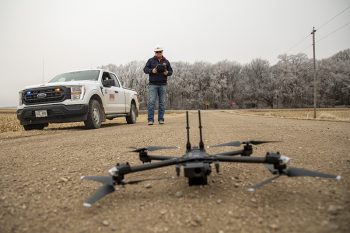Drones give OPPD an eye in the sky

Mark Gorseth peered through binoculars at the busted marker ball on a transmission line high above the Platte River.
Years ago, the OPPD line maintenance technician would have needed a helicopter to do an up-close inspection of the orange ball, which warns pilots and birds about the presence of power lines. Now, all it takes is a powerful little helper inside his pickup: an American-made Skydio X2 inspection drone.
From his vantage point on the river banks just south of Interstate 80, Gorseth sent the quadcopter humming up next to the ball, where it snapped half a dozen high-resolution photos that he would later forward to a repair crew.
“We use it as a tool,” Gorseth said, recalling the many times a drone has come in handy. “It’s another tool in our toolbox.”
In-house drone pilots
Drones are a big help for OPPD’s field workers, engineers and communications department, with so many uses that the utility has organized a group of in-house pilots to serve the district. Every pilot in the informal, 15-member group has earned a commercial license from the Federal Aviation Administration, allowing them to fly legally on the job. The utility’s drone pilots collectively logged about 200 flights last year, with 45 hours of flight time.

The group has also developed standard operating procedures to promote safe flying and holds quarterly safety briefings to discuss new technology, software, regulations, and any issues that arise in the field.
Longtime pilot Gary Wohlman, an OPPD line maintenance technician, uses his drone to check for broken cross arms on power poles, torn or loose material, damaged insulators, and other signs of wear on equipment. When trees encroach around power lines, his flying camera can get up-close images showing just how close limbs have grown to lines.
“It puts an exclamation point on an area that needs to be addressed,” Wohlman said. “It’s more than just a profile picture of something. You actually get the 3D effect of going through it.”
Ice jams, inspections, storm coverage
Wohlman’s drone soared into action earlier this month when ice jams clogged the Missouri River. Following the river’s curves near Blair, Fort Calhoun and Omaha, the unmanned quad captured smooth, crisp footage from a view that once would have required a much-more-expensive helicopter.
The camera’s wide-view lens showed the enormity of some of the ice jams, giving OPPD and others a sense of what they were facing. Monitoring the river helps OPPD ensure that it has enough water to sustain operations at its North Omaha and Nebraska City stations.
Other OPPD technicians fly drones to inspect substations or smokestacks at the utility’s power plants. The drone group also includes several engineers, who are also exploring ways to glean information using Skydio’s 2D and 3D scan functions.
Gary Martin, an OPPD construction inspector, launches his drone a few times a week for a variety of jobs.
Sometimes, he’s assessing damage done to crops during OPPD construction work so that the utility can fairly compensate the landowner. Other times, he records footage to help illustrate the size and scope of a proposed transmission line project for OPPD managers. When big storms hit, he jumps in as a backup to help document damage.
“It’s more of an informational tool,” Martin said. “Instead of driving through a bunch of fields, I can sit on the roadside and get a closer view of things without damaging anything that doesn’t need to be damaged.”
Getting a close-up view
Drones also come in handy for OPPD’s communications team, allowing the utility to share images of restoration work, storm damage and infrastructure projects with the public.

Collectively, the drone pilots have flown from as far north as Burt County, as far west as Colfax County, and south to all the way to the Nebraska-Kansas border.
OPPD still uses helicopters for some line inspections when it’s faster and more cost-efficient. When a big storm damages a lot of lines, for instance, or hits different areas of the service district simultaneously, it still makes sense to use a manned aircraft.
But for smaller areas or a super-close, detailed view of equipment, drones are often the better choice.
“It dramatically changes the views we can take of these lines,” said Shane Hanson, OPPD’s manager of transmission engineering.

Grant Schulte joined OPPD as a content generalist in 2022. He is a former reporter for The Associated Press, where he covered the Nebraska Legislature, state politics and other news for a global audience. He is a graduate of the University of Iowa and a proud Hawkeye. In his free time he enjoys running, reading, spending time with his wife, and all things aviation.
View all posts by Grant Schulte >







